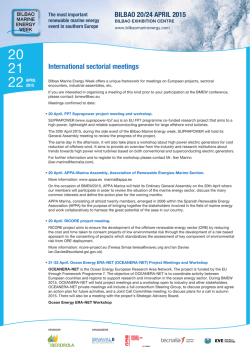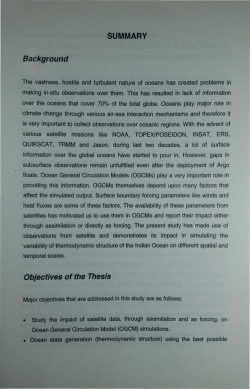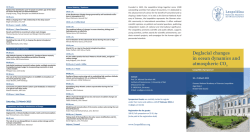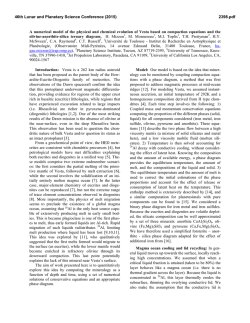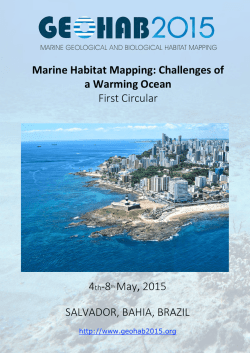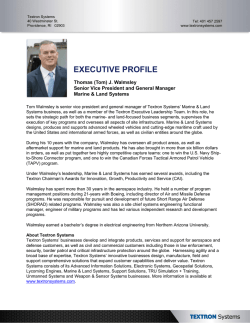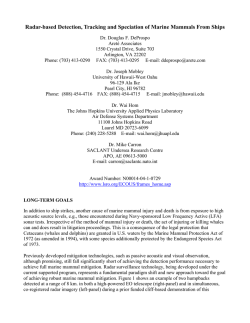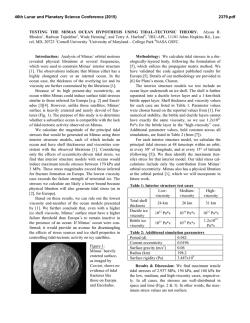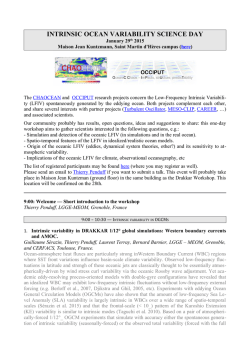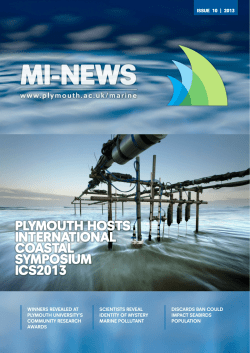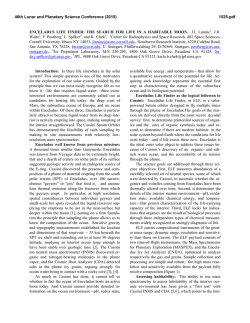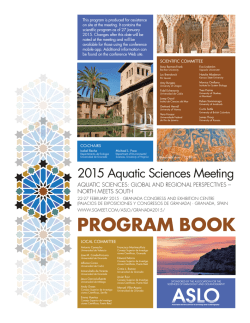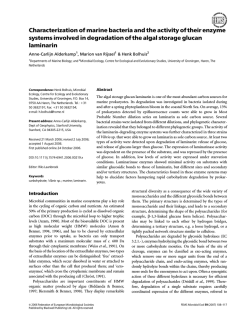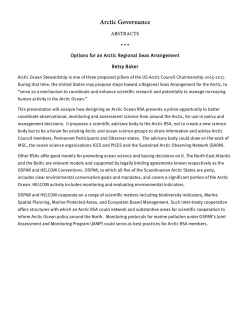
A Changing Ocean Policy Horizon for Marine Science
A Changing Ocean Policy Horizon
for Marine Science
David A. Ross
Marine Policy and Ocean Management Center
Woods Hole Oceanographic Institution
Woods Hole, Massachusetts
Abstract
A requisite for rational Exclusive Economic
Zone (EEZ) resource management is the continued integration
of marine science and policy. Policymakers will increasingly
need reliable scientific information as national borders expand
seaward and as technology affords greater access to more marine resources. Developments in marine science should open
new concepts of ocean and resource use, and these in turn will
pose new sets of policy issues. Some of the science-policy
possibilities include:
1. Expanding our knowledge of global ocean circulation,
thus improving fish stock assessment, weather prediction,
and innovative energy use;
2. continuing pollution research with a focus on the limits of
acceptable degradation of an environment (including the
problems of carbon dioxide in the atmosphere);
This work was supported through the generosity of the William H. Donner Foundation,
The Pew Memorial Trust, the Marine Policy and Ocean Management Center of the
Woods Hole Oceanographic Institution, and the Department' of Commerce, NOAA,
National Sea Grant College Program under Grant No. NA83AA-D-00049 (M/0-1). Woods
Hole Oceanographic Institution Contribution No. 5778.
Ocean Development and International Law, Volume 15, Numbers 3/4
009~320/85/040221-00$02.00/0
Copyright © 1985 Crane, Russak & Company, Inc.
221
David A. Ross
222
3. integrating the discovery and eventual exploitation of rnarine minerals with the environmental, legal, and political
constraints; and
4. ensuring access to all areas of the ocean for marine science research in light of the stringent conditions imposed
by some nations on research in their territorial seas and
exclusive economic zones.
Introduction
One requisite of rational Exclusive Economic Zone (EEZ) resource management is the continued integration of marine
science and policy. As national borders expand seaward and as
technology affords greater access to marine resources, the need
of policymakers for reliable scientific information will become
increasingly felt. This paper endeavors to describe likely future
policy roles for marine scientific research, particularly as they
relate to expanded development of EEZ resource potentials.
The past decades have seen major breakthroughs in our understanding of ocean phenomena. We have, among other things,
developed workable hypotheses for the formation and evolution
of the seafloor and have started to learn the implications of
ocean-atmosphere interactions. The future for productive science is equally exciting. Among the primary objectives in coming
years will be to increase our knowledge of the general circulation
of the ocean, and through this, to appreciate better the apparently critical effect of the ocean upon climate. This increased
understanding of ocean circulation will improve the opportunity
for specific ocean uses such as fishing and waste disposal. The
coming years may also pose further expansion of the plate
tectonic theory with an objective of finding new polymetallic
mineral deposits and understanding their origin. Technology,
including satellites, sophisticated buoys with numerous accurate
sensors, and ·powerful computers, will continue to provide a
crucial component in new oceanographic research.
The linkage of science and policy has generally not been
obvious to U.S. academic oceanographers. After the major
growth of oceanography following World War II, marine scientists usually had to satisfy program managers only with the basic
•
A Changing Ocean Policy Horizon
223
scientific importance of their effort rather than with its relevance,
its use, or its policy implications. If policy issues were a consideration, marine scientists would strive for those policies that
made it easier for them to do science.
The alternative, to pursue certain types of marine science to fit
or assist overall policy development, is a relatively new concept
for practicing marine scientists in academic research, but not as
much so for government laboratories or mandate agencies doing
pollution research. As a rule, policy followed marine science
rather than led it. That condition continues now, and probably
will into the future.
The beginning of the link between marine science and marine
policy (from the scientist's point of view) came in the mid-1970s
with the abrupt awareness of U.S. energy vulnerability and the
prospect that possible solutions could come from the marine
-environment, through increased offshore hydrocarbon development and innovations such as ocean thermal energy conversion
(OTEC). Added to these factors were the looming difficulties of
the Law of the Sea (LOS) Conference and funding restraints due
to inflation and later to budget deficits.
The promise of ocean science and its potential influence on
some parts of national policy may be considerable. National
economic impacts could come from development of new resources like manganese nodules, or conceivably polymetallic
sulfides, previously unobtainable resources such as hydrocarbons from the outer or deeper parts of the EEZ, or innovative
resources such as OTEC. Other impacts may come from the
security implications of global ocean knowledge, worldwide
megaproblems such as the increase of C0 2 in the atmosphere or
the probability of long-term climate prediction or climate control.
In all of these, marine science will continue to open new concepts of ocean and resource use, and these in turn will pose
policy issues. The following pages suggest some of the possibilities within these policy issues.
Ocean Circulation and Related Problems
A major obstruction to our clearer understanding of many critical marine processes has been our limited knowledge of ocean
224
David A. Ross
circulation. Seawater moves, sometimes with considerable turbulence, sometimes at almost immeasurable speed, and overall
with considerable temporal and spatial variation. Until the threedimensional motion of seawater over various time scales is understood, our success will always be limited in solving climate,
pollution, and related oceanographic problems.
The technological means may now exist for oceanographers to
make considerable improvements in collecting the data necessary for circulation studies over most areas of the ocean. Measurements can be made via remote sensing from satellites, a
worldwide pattern of floating instrumented buoys, chemical
tracers, and acoustical techniques, as well as traditional
oceanographic methods and procedures modeling. Satellites offer an excellent mechanism by which to obtain oceanographic
data over the entire globe (including foreign EEZs), but surfacetruth validation is often necessary for adequate interpretation of
data. The continuing development of new and powerful computers allows the reduction of vast amounts of data and, thus, the
modeling of complex systems such as the ocean.
In 1983, a National Academy Workshop concluded that an
oceanographic experiment on a global scale was now both feasible and desirable, and, as stated in the proceedings of the workshop, the major objective of the study ("World Ocean
Circulation Experiment") would be to understand the general
circulation of the global oceans well enough to predict ocean
response and feedback to long-term changes in the atmosphere. I
It was agreed that sufficient technologies do exist, but that a time
period of about a decade may be necessary to achieve the goal
realistically. Among the specific goals of this program are: to
develop a basic description of the present physical state of the
ocean, to determine the role of ocean heat transport and storage
in the heat budget of the earth, to determine seasonal and interannual oceanic variability on a global scale, and to estimate its
consequences.
Whether this program achieves these goals is, of course, hard
to anticipate. Nevertheless, the depth and the scale of understanding are essential for a variety of ocean uses and can have
spin-offs in seemingly unrelated areas. Knowledge of ocean
A Changing Ocean Policy Horizon
225
characteristics and circulation can be a very powerful tool. It
would allow considerable improvement in fish stock assessment,
weather prediction, and innovative energy use. The policy implications are likewise very broad and could lead to many new
and constructive uses of the ocean. How to implement these
uses, often before complete and adequate information exists, will
be the major challenge. One example is pollution.
Pollution
Some pollutants, such as PCBs and radioactive material from
nuclear explosions, are found in almost all parts of the ocean,
often far removed from obvious sources. This observation is
startling, considering the vast size of the ocean and the availability of some of these compounds for only 40 years or less. The
ocean, nevertheless, appears to have a high assimilative capacity
. for many substances and can tolerate additional input. Marine
disposal may be considerably less hazardous for some compounds than land disposal. In general, however, the long-term
assimilative capacity of the ocean for a specific compound or set
of compounds is unknown and eventual deleterious or irreversible effects cannot be predicted. At this time, outright prohibitions against ocean dumping are simply unreasonable and
unnecessary, especially as pollution problems on land seem to be
accelerating.
Present regulations often protect just one medium (air, water,
or land) from waste disposal use, often with little regard for the
impact of the regulation or whether it is focusing on the correct
medium for disposal. For example, burning chlorinated organic
chemical wastes at sea seems to be the best solution at present
for disposal of these pollutants, in part because seawater with its
high buffering capacity will neutralize hydrochloric acid-the
main product of this technique. Perhaps other categories of
chemicals could be included as technology improves.
Among the major problems for pollution research (and environmental research in general) is the ability to extrapolate from
short-term, small area results to longer, more realistic, larger
time and area scales. Policy questions focus on the limits of
226
David A. Ross
acceptable degradation of an environment (it should be emphasized that what is scientifically acceptable may be quite different
from what is economically or socially acceptable). Further, there
must be a meaningful comparison between the various disposal
media. The accepted policy should be flexible as new technology
and more information become available. Likewise, once a decision is made, it should not mean an end to the research.
Disposal of radioactive material is a special case because of
the long-lived nature (10,000 years or more) of some compounds
involved. The choice of a permanent disposal site is a scientifically, politically, and socially difficult problem. Burial in the
seafloor is an appealing option. Although questions remain,
nothing to date has ruled out the deep-sea disposal option. The
key scientific question is whether the sediments have a large
enough absorption coefficient to prevent any escaping radionuclides from reaching the water column. Obviously a choice of
the seabed for the disposal of high-level radioactive wastes would
require a major analysis of legal, political, and international
implications. This could be even more complex than the scientific
and technical aspects.
C0 2 and the Greenhouse Problem
Over the last one hundred years there has been a measurable
increase in atmospheric C0 2 levels due to industrial activities.
While carbon dioxide in the atmosphere is essentially pervious
to incoming energy from the sun, it traps a portion of the heat
energy escaping from the earth. This is known as the "greenhouse effect" and, as the C0 2 increases, it is expected to result in
higher global temperatures. Since it appears that the amount of
atmospheric C0 2 may double in the next century, the questions
then are, What will be the effect, can it be controlled, and what
policy should governments follow?
The data on the rate of C0 2 increase vary, and potential largescale interactions make modeling complex. Another still debatable point is how much of the C0 2 can be absorbed by the ocean
without causing other problems. A 1983 National Research
Council (NRC) report concluded that there probably will be a
A Changing Ocean Policy Horizon
227
worldwide increase in temperature and rise in sea level in future
years. 2 If correct, this will have enormous impact on agriculture
and coastal use for many countries. In spite of these serious
possible effects, the main alternative, stopping the burning of
fossil fuels, also has serious consequences. The NRC suggested,
due to the uncertainty of both the scientific data and the economic and social variables, that no steps be taken at this time,
other than the continued monitoring of C0 2 levels and climatic
and environmental responses.
Mineral Resources
Certainly one of the more exciting scientific events of the past
two decades has been the discovery of vents emitting hot liquids
and minerals along parts of the oceanic spreading centers. The
vast amount of material discharged over time has changed many
ideas about chemical processes in the ocean and the origin of
seawater. Associated with these vents are unique forms of life
whose sustenance comes from chemosynthesis rather than sunlight. Some have suggested that this environment is similar to
that wherein life first originated. But the greatest interest has
focused on the mineral deposits (generally called polymetallic
sulfides) associated with the vents. These deposits contain intriguing amounts of zinc, copper, iron, with accessory amounts
of silver, vanadium, gold, and platinum. Because of very limited
data, an estimate of the value of these deposits is premature at
this time, although several rather optimistic and exaggerated
estimates have appeared in the press.
Some deposits have been found on the Juan de Fuca Ridge off
Washington and Canada; another potential site closer to the
United States is the Gorda Ridge. New exploration technologies
and techniques such as SEABEAM (wide-angle multibeam echo
sounding), side scan sonar, and bottom drilling capabilities, combined with the now testable plate tectonic hypotheses, should
make further discoveries and resource evaluation easier in the
coming years.
A more recent discovery has been the finding of thin (1-5
centimeters) cobalt-rich manganese crusts along the flanks of
228
David A. Ross
several islands and seamounts in the central Pacific. Their shallow depth (1,000 to about 3,000 meters) and the fact that many
occur within the U.S. EEZ have generated interest on the part of
a number of government agencies. Another discovery has been
the detection of hot springs on seamounts. One, about 500 kilometers off British Columbia and Washington, has sulfide deposits
and some of the unique organisms found along the spreading
centers. The shallowness of seamounts (about 1500 meters in this
case) and the relatively modest relief of the region may make
these deposits more technically accessible than those found on
spreading centers.
Development of these potential resources will not be easy for
various reasons, including the need to develop new technologies,
the nature of international metal markets, the unknown extent
and grade of deposits, and the rugged relief of the deposits. At
present, the Minerals Management Service (MMS) of the Department of Interior, and the National Oceanic and Atmospheric
Administration (NOAA) are examining methods that would
provide access for commercial interests to these deposits. Many
questions are yet to be answered: Are the deposits economic? Is
enough information available for the government to proceed with
a lease sale? How should the deposit be leased? The economic
unknowns mentioned above will certainly add to exploitation
costs.
One of the more critical issues for the mining of deep-sea
marine minerals concerns the U.N. Convention on the Law of the
Sea and the present U.S. position not to adhere to it. This treaty
has specific rules for the mining of mineral resources beyond an
EEZ. How the United States can (or even may) operate in this
part of the ocean is at present unclear. However, most known
· polymetallic sulfide deposits and cobalt-rich manganese crusts
occur within established EEZs. Other related questions include:
Will marine mineral mining interfere with other traditional uses
of coastal waters? What are the environmental impacts of mining? And what are the appropriate roles of the government,
industry, and academe in exploring and eventually developing
these deposits?
For the United States to claim and exploit some of the known
A Changing Ocean Policy Horizon
229
deposits off its coasts may require it to define its outer continental shelf-an area that can extend beyond its EEZ. Article 76 in
the U.N. Convention offers various mechanisms for defining the
outer continental shelf when it extends beyond 200 nautical miles
(as it does for much of the United States). These definitions will
be very hard to apply, sometimes impossible. Alternatives, including the so-called Hedberg Formula, could also be considered. The United States will ultimately have to make a choice on
how to define its outer continental shelf boundary (using either
Article 76 in the U.N. Convention or some other criteria), a
choice that might set an example for other countries, and will
clearly have implications for other ocean uses, including possible
boundary conflicts with Canada and Mexico.
Fisheries
One category of marine use where policy has clearly outrun
science is fisheries management. Although fishing is among the
most important uses of the ocean, there is considerable controversy as to how to manage fisheries. Their distribution in the
ocean and the critical oceanographic factors that influence this
distribution are not well known. Indeed, it is not even clear if the
continuation of conventional fisheries studies will give us further
insight. The issue becomes even more confusing when the consequences of pollution (both catastrophic and chronic) are
weighed with those of natural fluctuations and possible overfishing. Regardless of these uncertainties, fishery management plans
have been developed and implemented in the United States.
Specific and detailed scientific studies are needed to understand
the interactions of fish with the environment as well as interactions between the various species of fish and other marine organisms. Among the critical questions are: What controls the
number of individuals reaching a catchable size each year? And
does fishing itself represent an important impact on commercial
species? Given the large number of unknowns, the research
protocol is far from clear.
Other important knowledge gaps include the relative abundance and trends of specific fisheries; this information is needed
230
David A. Ross
so that reasonable predictions can be made and used in management schemes. Any scientifically realistic management scheme
should focus on a multi-species approach within a given region.
At the present time our data and models are neither realistic nor
complete, and, as previously stated, it is often not possible to
separate natural impacts on a system from human impacts, such
as that of fishing pressure. Even if all these scientific questions
were answered (or answerable), there are still critically important
economic, political, and social questions that must be considered
in any effective management plan.
Fisheries management illustrates an area for which policy is
made and will continue to be made in the absence of, or with a
lack of, scientific knowledge. Aquaculture also provides an opportunity on which to capitalize since many of the attendant
biological problems have been moderated and markets already
exist for the products. The outstanding problems are legal and
social ones, such as legally setting aside (reserving) specific
areas to be used for the culture of shellfish or the growth of
salmon. For the fishery managers of the United States these are
hard questions. They have to consider where management is
applicable, what its objectives should be, and exactly what
should be managed-fish or fishermen. Until an adequate understanding of the processes controlling fish, especially within the
total ecosystem, is achieved, fishery management may continue
to be less than successful.
Ocean Access and the EEZ
An important requirement for achieving the above and other
scientific objectives is access to all areas of the ocean. The free
and essentially complete ocean access for marine science that
existed in the past has clearly been lost due to changing coastal
state attitudes as reflected in the U.N. Convention. Scientific
research in the world's 200-nautical-mile EEZs will involve new
costs and commitments, additional time for developing research
programs, and possibly delays in implementation for U.S. scientists. Nevertheless, an active research program in these waters
(which currently supply about 90 percent of the world's present
ocean fish catch and all of the offshore oil and gas) is necessary
•
A Changing Ocean Policy Horizon
231
for our scientific growth. New policies and approaches will be
needed to ensure U.S. marine scientists continued access to
foreign waters and to prevent further research restrictions in all
parts of the ocean. A national policy that maximizes access and
other benefits for U.S. scientists seems appealing. However,
there are risks in implementing scientific efforts that are developed without adequate discussion and consensus within the
scientific community.
The United States is deliberating its continued participation in
international scientific forums such as the Intergovernmental
Oceanographic Commission and regional organizations such as
IOCARIBE. Further, the federal government could, as appropriate in its various interactions and negotiations with other governments, specifically try to develop favorable arrangements,
treaties, etc., for marine scientific activities. In regard to specific
countries such as Mexico and Canada in whose waters much
U.S. research occurs, bilateral marine scientific arrangements
have been considered with the cautionary note that bilaterals
may have hidden costs that need special evaluation.
In general, the marine scientific community has often been
effective in defining and implementing long-term programs. Yet,
there is limited experience as well as enthusiasm within this
community in dealing with issues pertaining to the U.N. Convention on the Law of the Sea. One concern is that scientists will
avoid controversial geographical areas and Convention issues
and will focus their research in more accessible regions. If so,
this will ensure that the marine science conditions in the treaty
esse!Jtially become restraints, discouraging important research
in foreign EEZs. It should be stressed that EEZs encompass that
part of the ocean which often has the most variability, receives
most of the land erosion and waste products, and is also the most
used and abused part of the ocean. To exclude this region from
active research would narrow our effectiveness in ocean science
studies.
Fortunately, however, an excellent opportunity exists for encouraging EEZ research-the declaration by the United States
of its own EEZ. The President, in proclaiming such a zone, has
claimed mineral resources (most fisheries were already claimed
within a 200-mile zone by the United States in 1976) out to 200
232
David A. Ross
nautical miles. A further extension is possible. The size of the
U.S. EEZ, including that of the Commo.nwealth of Puerto Rico,
the Commonwealth of the Northern Mariana Islands, and the
U.S. overseas territories and possessions, is about 3. 7 billion
acres-compared to 2.3 billion acres of onshore land. The size of
this territorial acquisition is unmatched in U.S. history and offers
exciting opportunities for scientific and technological research.
A well-planned, national EEZ program could yield important
benefits to the United States economy and could serve as a
model for foreign countries in developing their EEZs. For the
United States much is already known about the types of its
potential ocean resources, although little is known about their
abundance, their impact on the environment, or the technology
necessary for their exploitation. Thus, we are presented with a
unique opportunity to develop a broad scientific and environmental program for the U.S. EEZ, an opportunity that could lead
to adequate management and conservation schemes being in
place when exploitation is appropriate.
Conclusion
The above examples show some future marine science objectives
and how they relate to policy. It is anticipated that marine science in the future will proceed independently or ahead of policy
issues. However, the implication of developments such as the
U.N. Convention on the Law of the Sea and possible governance
schemes for the U.S. EEZ suggests that marine science in the
future will be working under more rigorous constraints than in
the past.
Notes
l. National Research Council, Global Observations and Understanding of the General Circulation of the Ocean, Workshop
Proceedings, August 1983 (Washington, D.C.: National Academy
Press, 1984).
2. National Research Council, Changing Climate (Washington,
D.~.: National Academy Press, 1983).
·ol
© Copyright 2025
